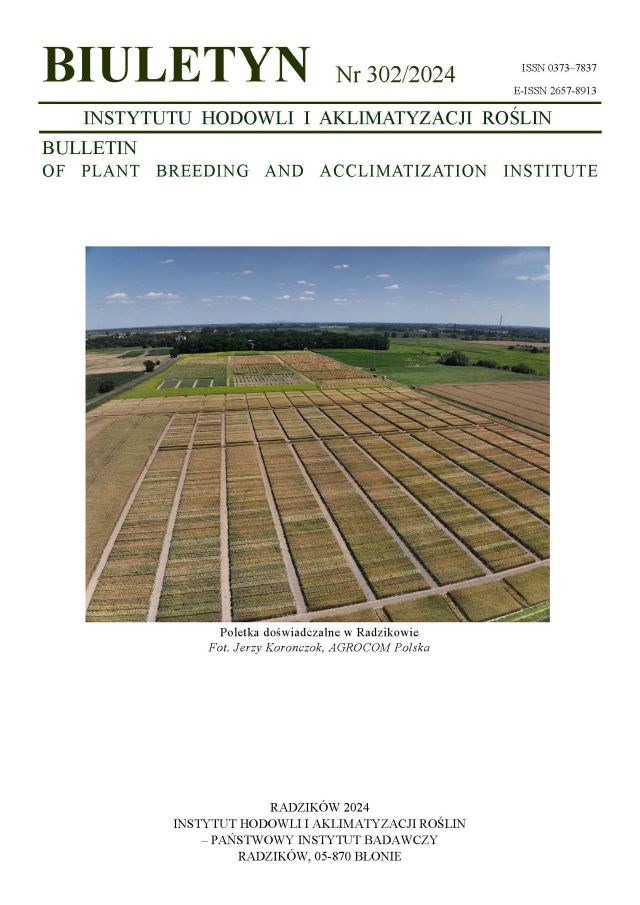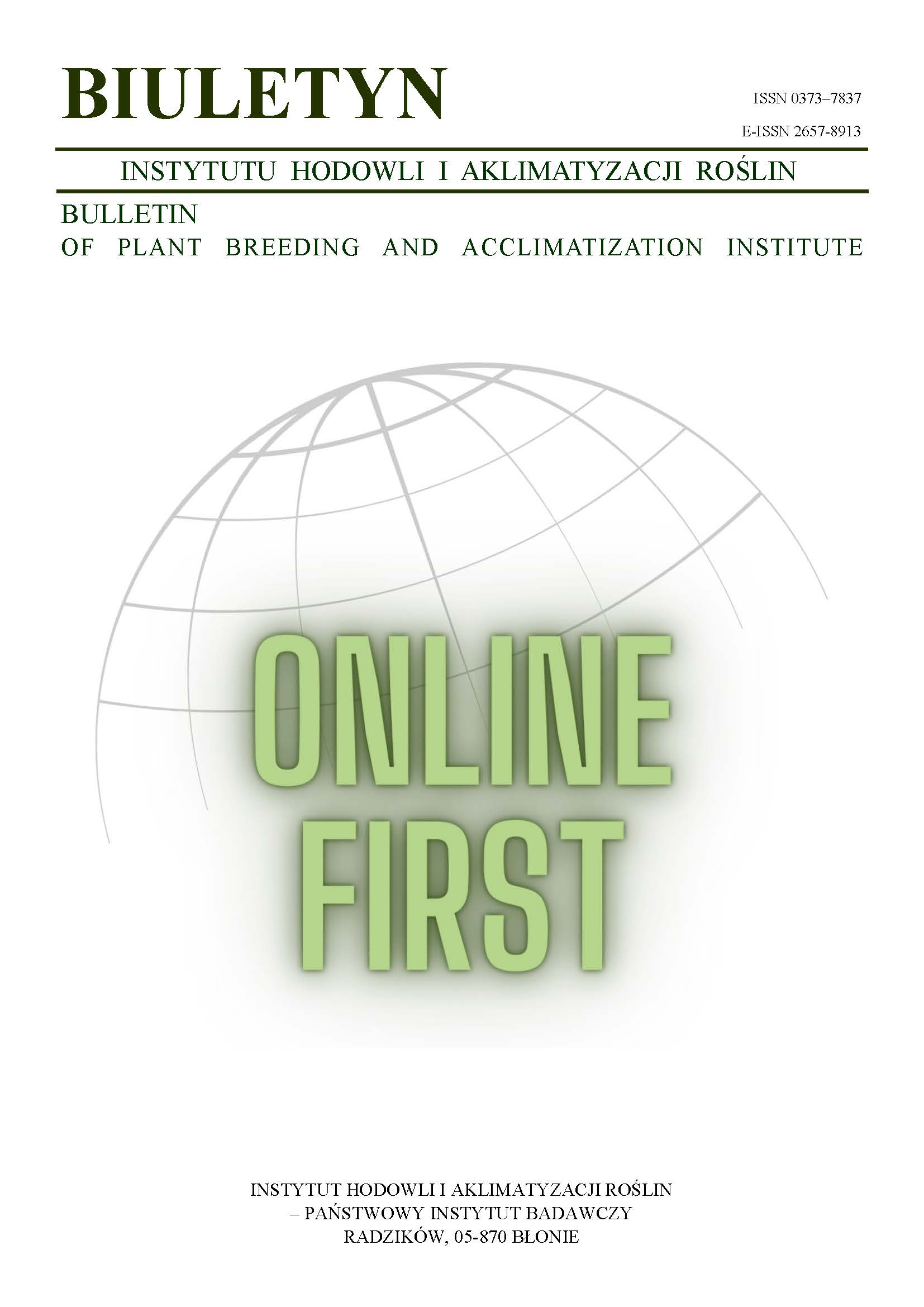Genetyczne możliwości ulepszania jakości ziarna pszenicy ozimej Triticum aestivum L. w efekcie hybrydyzacji introgresywnej z Triticum durum Desf.
Józef Pilch
j.pilch@ihar.edu.plZakład Oceny Jakości i Metod Hodowli Zbóż, Instytut Hodowli i Aklimatyzacji Roślin w Krakowie (Poland)
Abstrakt
W pracy analizowano wartość technologiczną ziarna 64 ozimych linii introgresywnych T. aestivum L./ T. durum Desf. Ocena technologiczna obejmowała 4 letnie wyniki zawartości białka ogółem (%), wskaźnika sedymentacji Zeleny’ego (ml), liczby opadania (s), wartości wypiekowej (klasy E, A, B, C) i elektroforezę SDS-PAGE wysokocząsteczkowych glutenin. Wyniki te porównano z wynikami uzyskanymi dla odmiany jakościowej Begra. Większość badanych linii wykazywała wartości wskaźników, które dorównywały (klasa A) lub przewyższały (klasa E) odmianę Begra. Zawartość białka klasy E miało 46,8% linii, wskaźnik sedymentacji Zeleny’ego klasy E — 21,8% linii, liczbę opadania klasy E — 96,8% linii i wartość wypiekową klasy E miało 18,6% linii. Wykonana elektroforeza wysokocząsteczkowych glutenin wykazała (1) obecność homeologicznych alleli w loci Glu-A1 i Glu-B1 u 85,9% linii, (2) rozbicie alleliczności w locus Glu- D1 i utworzenie nowej kombinacji podjednostek 5+12 u 6,3% linii, (3) introgresje obcych alleli w loci Glu-1 o nieznanych podjednostkach u 7,8% linii. Uzyskane wyniki wskazują, iż hybrydyzacja introgresywna T. aestivum L. z pszenicą tetraploidalną gatunku T. durum Desf. prowadzić może do pod¬wyższenia wartości technologicznej ziarna u pszenicy ozimej T. aestivum L. wynikającego z introgresji alleli genomów A, B lub efektów pasażowania obcymi chromosomami.
Słowa kluczowe:
Triticum aestivum L., Triticum durum Desf., gluteniny wysokocząsteczkowe, hybrydyzacja introgresywna, wskaźniki technologiczne, ziarnoBibliografia
Autran J. C., Galterio G. 1989. Associations between electrophoretic composition of protein, quality characteristics and agronomic attributes of durum wheat. II. Protein quality association. J. Cereal Sci. 9: 195 — 215.
DOI: https://doi.org/10.1016/S0733-5210(89)80002-5
Google Scholar
Anderson O. D., Abraham-Pierce F. A., Tam A. 1998. Conservation in wheat high-molecular-weight glutenin gene promoter sequences: comparisons among loci and among alleles of the Glu-B1-1 locus. Theor. Appl. Genet. 96: 568 — 576.
DOI: https://doi.org/10.1007/s001220050775
Google Scholar
Baulcombe D. C., Huttly A. K., Martienssen R., Barker R. F., Jarvis M. G. 1987. A novel wheat alpha- amylase gene (L-Amy 3). Mol. Gen. Genet. 209: 33 — 34.
DOI: https://doi.org/10.1007/BF00329833
Google Scholar
Blanco A., Bellomo M. P., Lotti C., Pasquolone A. 1998. Mapping of quantitative trait loci for grain quality using recombinant inbred lines of durum wheat. Proc. of the 10th EWAC Meeting, Viterbo — Italy (Ed. C. Ceoloni, Worland A. J.: 106 — 109.
Google Scholar
Branlard G., Autran J. C., Monneveux P. 1989. High molecular weight glutenin subunits in durum wheat (Triticum durum). Theor. Appl. Genet. 78: 353 — 358.
DOI: https://doi.org/10.1007/BF00265296
Google Scholar
Carrillo J. M., Rousset M., Qualset C. O., Kasarda D. D. 1990. Use of recombinant inbred lines of wheat for study of associations of high-molecular weight glutenin subunit alleles to quantitative traits. I. Grain yield and quality prediction tests. Theor. Appl. Genet. 73: 321 — 330.
DOI: https://doi.org/10.1007/BF01186074
Google Scholar
Ciaffi M., Benedeltelli S., Giorgi B., Porceddu E., Lafiandra D. 1992. Seed storage proteins of Triticum turgidum spp. dicoccoides and their effects on technological quality in durum wheat. Plant Breeding 107: 309 — 319.
DOI: https://doi.org/10.1111/j.1439-0523.1991.tb00554.x
Google Scholar
Dessalegn T., Van Deventer C. S., Labuschagne M. T., Maartens H. 2003. B-LMW glutenin and y-gliadin composition of Ethiopian durum wheat genotypes and their association with some quality traits. Cereal Res. Commun. 31, 3–4: 453 — 457.
DOI: https://doi.org/10.1007/BF03543378
Google Scholar
Dexter J. E., Matsuo R. R. 1987. Relationship between durum wheat properties and pasta dough rheology and spaghetti cooking quality. J. Agric. Food. Chem. 26: 899 — 905.
DOI: https://doi.org/10.1021/jf60231a034
Google Scholar
Dong H., Cox T. S., Sears R. G., Lockhard G. L. 1991. High molecular weight glutenin genes: Effects on quality in wheat. Crop.Sci. 31: 971 — 979.
DOI: https://doi.org/10.2135/cropsci1991.0011183X003100040027x
Google Scholar
D’Ovidio R, Simeone M., Masci S., Porceddu E. 1997. Molecular characterization of a LMW-GS gene located on chromosome 1B and the development of primers specific for the Glu-B3 complex locus in durum wheat. Theor. Appl. Genet. 95: 119 — 126.
DOI: https://doi.org/10.1007/s001220050671
Google Scholar
Forde J., Malpica J. M., Halford N. G., Shevry P. R., Anderson O. D., Green F. C. 1985. The Nucleotide sequence of a HMW glutenin subunit gene located on chromosome 1A of wheat (Triticum aestivum L.) Nucleic Acids Res. 13: 6817 — 6832.
DOI: https://doi.org/10.1093/nar/13.19.6817
Google Scholar
Juhasz A., Larroque O. R., Tamas L., Hsam S. L. K., Zeller F. J., Bekes F., Bedo Z. 2003. Bankuti 1201 an old Hungarian wheat variety with special storage protein composition. Theor. Appl. Genet. 107: 697 — 704.
DOI: https://doi.org/10.1007/s00122-003-1292-2
Google Scholar
Kaczyński L. 2002. Pszenica ozima. Lista opisowa odmian 2002. (wyd. E. Gacek, Centralny Ośrodek Badania Odmian Roślin Uprawnych, Słupia Wielka): 20 — 35.
Google Scholar
Kazman E., Lelley T. 1994. Rapid incorporation of D-genome chromosomes into A and/ or B genomes of hexaploid triticale. Plant Breeding 113: 89 — 98.
DOI: https://doi.org/10.1111/j.1439-0523.1994.tb00710.x
Google Scholar
Klockiewicz-Kamińska E., Brzeziński W. J. 1997. Metoda oceny i klasyfikacji jakościowej odmian pszenicy. Wiad. Odm. COBORU 67: 1 — 18.
Google Scholar
Lafferty J., Lelley T. 2001. Introduction of high molecular weight glutenin subunits 5+10 for the improvement of the bread-making quality of hexaploid triticale. Plant Breeding 120 (1): 33 — 37.
DOI: https://doi.org/10.1046/j.1439-0523.2001.00567.x
Google Scholar
Lin C. Y., Shepherd K. W. 1996. Variation of B subunits of glutenin in durum wild and less-widely cultivated tetraploid wheats. Plant Breed. 115: 172 — 178.
DOI: https://doi.org/10.1111/j.1439-0523.1996.tb00896.x
Google Scholar
Lorenzo A., Kronstad W. E., Vieira L. C. E. 1987. Relationship between high molecular weight glutenin subunits and loaf volume in wheat as measured by the sodium dodecyl sulfate sedimentation test. Crop. Sci. 27: 253 — 257.
DOI: https://doi.org/10.2135/cropsci1987.0011183X002700020026x
Google Scholar
Lukaszewski A. J., Brzezinski W., Klockiewicz-Kaminska E. 2000. Transfer of the Glu-D1 locus encoding high molecular weight glutenin subunits 5+10 from bread wheat to diploid rye. Euphytica 115: 49 — 57.
DOI: https://doi.org/10.1023/A:1004085528286
Google Scholar
Lukaszewski A. J., Curtis C. A. 1992. Transfer of the Glu-D1 gene from chromosome 1D of bread wheat to chromosome 1R in hexaploid triticale. Plant Breeding 109: 203 — 210
DOI: https://doi.org/10.1111/j.1439-0523.1992.tb00174.x
Google Scholar
Lukaszewski A. J., Curtis C. A. 1994. Transfer of the Glu-D1 gene from chromosome 1D to chromosome 1A in hexaploid triticale. Plant Breeding 112: 177 — 182.
DOI: https://doi.org/10.1111/j.1439-0523.1994.tb00668.x
Google Scholar
Mac Gregor E. A., Mac Gregor A. W. 1987. Studies of cereal L-amylases using cloned DNSA. Rev. Biotech. 5: 129 — 142.
DOI: https://doi.org/10.3109/07388558709086973
Google Scholar
Odenbach W., Mahgoub E. S. 1988. Relationships between HMW glutenin subunit composition and the sedimentation value in reciprocal sets of inbred backcross lines derived from two winter wheat crosses. Proc. 7 th Int.Wheat Genet. Symp., Cambridge (England): 987 — 991.
Google Scholar
Payne P. I., Lawrence G. J. 1983. Catalogue of alleles for the complex gene loci Glu-A1, Glu-B1, Glu-D1 which code for high-molecular-weight subunits of glutenin in hexaploid wheat. Cer. Res. Commun. 11: 29 — 36.
Google Scholar
Pilch J. 1987. Substytucje i delecje heterochromatynowe chromosomów żyta (Secale cereale L.) oraz ich związek z niektórymi cechami użytkowymi pszenżyta heksaploidalnego. Hod. Rośl. Aklim. 30, 3/4: 1 — 52.
Google Scholar
Pilch J. 1996. Performance of interspecific and intergeneric hybrids of Triticum aestivum L. for wheat improvements. Part I. Performance of winter generations F3–F5 of T. aestivum L. with Triticum {2x, 4x}, Aegilops {2x}, and Elymus {4x} species in respect of some characters of spike. Plant Breed. and Seed Sci. vol. 40, no. 3-4: 73 — 62.
Google Scholar
Pilch J., Głowacz E., Cygankiewicz A. 1999. Wartość wypiekowa ziarna mieszańców pszenicy pochodzących z krzyżowań międzygatunkowych i międzyrodzajowych. Biul. IHAR 210: 71 — 83.
Google Scholar
Pilch J. 2002. Transformacje cech kłosa pszenicy Triticum aestivum L. z wykorzystaniem międzygatunkowej i międzyrodzajowej hybrydyzacji. Zeszyty Problemowe Postępów Nauk Rolniczych z. 488: 207 — 213.
Google Scholar
Rogers W. J., Miller T. E., Payne P. I., Seekings J. A., Sayers E. J., Holt L. M., Law C. N. 1997. Introduction to bread wheat (Triticum aestivum L.) and assessment for bread-making quality of alleles from T. boeoticum Boiss. ssp. thoudar at Glu-A1 encoding two high-molecular-weight subunits of glutenin. Euphytica 93: 19 — 29.
DOI: https://doi.org/10.1023/A:1002991206350
Google Scholar
Sabelli P. A., Shevry P. R. 1991.Characterization and organization of gene families at the Gli-1 loci of bread and durum wheat’s by restriction fragment analysis. Theor. Appl. Genet. 83: 209 — 216.
DOI: https://doi.org/10.1007/BF00226253
Google Scholar
Schepers J., Keizer L. C. P., Kolster P. 1993. The relation between high molecular weight glutenin subunits, bread-making quality and agronomic properties of winter wheat. Cereal Res. Commun. 21, no.4: 289 — 296.
Google Scholar
Szwed-Urbaś K., Segit Z., Mazurek H. 1997. Parametry jakościowe ziarna krajowych linii pszenicy twardej (Triticum durum Desf.). Biul. IHAR 204: 129 — 140.
Google Scholar
Turchetta T., Ciaffi M., Porceddu E., Lafiandra D. 1995. Relationship between electrophoretic pattern of storage proteins and gluten strength in durum wheat landraces from Turkey. Plant Breeding 114: 406 — 412.
DOI: https://doi.org/10.1111/j.1439-0523.1995.tb00821.x
Google Scholar
Vitellozzi F. Ciaffi M., Dominici L., Ceoloni C. 1997. Isolation of a chromosomally engineered durum wheat line carrying the common wheat Glu-D1d allele. Agronomie 17: 413 — 419.
DOI: https://doi.org/10.1051/agro:19970805
Google Scholar
Zillman R.R., Bushuk W. 1979. Wheat cultivar identification by gliadin electrophoregrams. III. Can. J. Plant Sci. 59: 287.
DOI: https://doi.org/10.4141/cjps79-048
Google Scholar
Autorzy
Józef Pilchj.pilch@ihar.edu.pl
Zakład Oceny Jakości i Metod Hodowli Zbóż, Instytut Hodowli i Aklimatyzacji Roślin w Krakowie Poland
Statystyki
Abstract views: 72PDF downloads: 30
Licencja
Prawa autorskie (c) 2005 Józef Pilch

Utwór dostępny jest na licencji Creative Commons Uznanie autorstwa – Na tych samych warunkach 4.0 Miedzynarodowe.
Z chwilą przekazania artykułu, Autorzy udzielają Wydawcy niewyłącznej i nieodpłatnej licencji na korzystanie z artykułu przez czas nieokreślony na terytorium całego świata na następujących polach eksploatacji:
- Wytwarzanie i zwielokrotnianie określoną techniką egzemplarzy artykułu, w tym techniką drukarską oraz techniką cyfrową.
- Wprowadzanie do obrotu, użyczenie lub najem oryginału albo egzemplarzy artykułu.
- Publiczne wykonanie, wystawienie, wyświetlenie, odtworzenie oraz nadawanie i reemitowanie, a także publiczne udostępnianie artykułu w taki sposób, aby każdy mógł mieć do niego dostęp w miejscu i w czasie przez siebie wybranym.
- Włączenie artykułu w skład utworu zbiorowego.
- Wprowadzanie artykułu w postaci elektronicznej na platformy elektroniczne lub inne wprowadzanie artykułu w postaci elektronicznej do Internetu, lub innej sieci.
- Rozpowszechnianie artykułu w postaci elektronicznej w internecie lub innej sieci, w pracy zbiorowej jak również samodzielnie.
- Udostępnianie artykułu w wersji elektronicznej w taki sposób, by każdy mógł mieć do niego dostęp w miejscu i czasie przez siebie wybranym, w szczególności za pośrednictwem Internetu.
Autorzy poprzez przesłanie wniosku o publikację:
- Wyrażają zgodę na publikację artykułu w czasopiśmie,
- Wyrażają zgodę na nadanie publikacji DOI (Digital Object Identifier),
- Zobowiązują się do przestrzegania kodeksu etycznego wydawnictwa zgodnego z wytycznymi Komitetu do spraw Etyki Publikacyjnej COPE (ang. Committee on Publication Ethics), (http://ihar.edu.pl/biblioteka_i_wydawnictwa.php),
- Wyrażają zgodę na udostępniane artykułu w formie elektronicznej na mocy licencji CC BY-SA 4.0, w otwartym dostępie (open access),
- Wyrażają zgodę na wysyłanie metadanych artykułu do komercyjnych i niekomercyjnych baz danych indeksujących czasopisma.
Inne teksty tego samego autora
- Józef Pilch, Efektywność introgresji genów Glu-1 wysokocząsteczkowych glutenin w zwiększaniu wartości wypiekowej ziarna zbóż — przegląd literatury , Biuletyn Instytutu Hodowli i Aklimatyzacji Roślin: Nr 243 (2007): Wydanie regularne
- Józef Pilch, Introgresje genów z gatunków spokrewnionych taksonomicznie w ulepszeniach pszenicy Triticum aestivum L. i innych roślin uprawnych , Biuletyn Instytutu Hodowli i Aklimatyzacji Roślin: Nr 260/261 (2011): Wydanie regularne
- Józef Pilch, Wykorzystanie genów z gatunków diploidalnych, tetraploidalnych i heksaploidalnych pszenicy Triticum L. w odmianach pszenicy heksaploidalnej Triticum aestivum L. , Biuletyn Instytutu Hodowli i Aklimatyzacji Roślin: Nr 262 (2011): Wydanie regularne
- Józef Pilch, Możliwości wykorzystania krzyżowania introgresywnego w hodowli pszenicy ozimej Triticum aestivum L. , Biuletyn Instytutu Hodowli i Aklimatyzacji Roślin: Nr 235 (2005): Wydanie regularne
- Józef Pilch, Wpływ genomów A, B Triticum durum Desf. na wartość technologiczną ziarna pszenicy ozimej Triticum aestivum L. , Biuletyn Instytutu Hodowli i Aklimatyzacji Roślin: Nr 230 (2003): Wydanie regularne
- Józef Pilch, Uwarunkowania genetyczne cech morfologicznych kłosa pszenicy (Triticum aestivum L.) , Biuletyn Instytutu Hodowli i Aklimatyzacji Roślin: Nr 228 (2003): Wydanie regularne
- Józef Pilch, Możliwości wykorzystania krzyżowania introgresywnego w hodowli pszenicy ozimej Triticum aestivum L. , Biuletyn Instytutu Hodowli i Aklimatyzacji Roślin: Nr 235 (2005): Wydanie regularne














